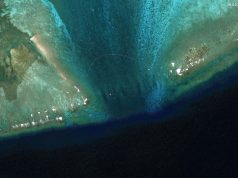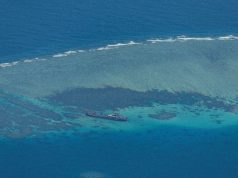
WASHINGTON — (UPDATE – 10:14 a.m.) While attention in Asia has been distracted by the North Korean nuclear crisis in the past year, China has continued to install high-frequency radar and other facilities that can be used for military purposes on its man-made islands in the South China Sea, a U.S. think tank said on Thursday.
The revelation came as China’s naval chief has told his Australian counterpart that his country’s actions on the South China Sea run counter to the general trend of peace and stability in the disputed waterway.
Australia, a close ally of the United States, has repeatedly expressed concern over the disputed South China Sea, where China has built manmade islands, some of which are equipped with runways, surface-to-air missiles and radars.
Australia has previously drawn criticism from China for running surveillance flights over the South China Sea and supporting U.S. freedom of navigation exercises there.
However, Australia has not conducted a unilateral freedom of navigation voyage of its own.
Chinese activity has involved work on facilities covering 72 acres (29 hectares) of the Spratly and Paracel islands, territory contested with several other Asian nations, according to the Asia Maritime Transparency Initiative of Washington’s Center for Strategic and International Studies.
The report cited satellite images.
The United States and its allies oppose China’s building of artificial islands in the South China Sea and their militarization, given concerns Beijing plans to use them to deny access to strategic routes.
The report said that in the last several months China had constructed what appeared to be a new high-frequency radar array at the northern end of Fiery Cross Reef in the Spratlys.
Subi Reef had seen tunnels completed that were likely for ammunition storage and another radar antenna array and radar domes, the report said.
Construction on Mischief Reef included underground storage for ammunition and hangars, missile shelters and radar arrays.
Smaller-scale work had continued in the Paracel Islands, including a new helipad and wind turbines on Tree Island and two large radar towers on Triton Island.
It said the latter were especially important as waters around Triton had been the scene of recent incidents between China and Vietnam and multiple U.S. freedom-of-navigation operations, which the U.S. navy has used to assert what it sees as its right to free passage in international waters.
Woody Island, China’s military and administrative headquarters in the South China Sea, saw two first-time air deployments “that hint at things to come at the three Spratly Island air bases farther south,” the report said.
At the end of October, the Chinese military released images showing J-11B fighters at Woody Island for exercises, while on November 15, AMTI spotted what appeared to be Y-8 transport planes, a type that can be configured for electronic surveillance.
The Pentagon has conducted several patrols near Chinese-held South China Sea territory this year, even as it has sought China’s help in northeast Asia to press North Korea to give up its nuclear weapons program.
On Tuesday, U.S. Secretary of State Rex Tillerson reiterated a call for a “freeze” in China’s island building and said it was unacceptable to continue their militarization.
China claims most of the South China Sea, a strategic waterway where $3 trillion worth of goods passes every year. Vietnam, the Philippines, Malaysia, Taiwan and Brunei all have overlapping claims.
Meeting in Beijing, China’s navy commander Shen Jinlong told Australian Vice Admiral Tim Barrett that at present the situation in the South China Sea was “steady and good,” China’s Defense Ministry said in a statement late on Thursday.
“But in the last year the Australian military’s series of actions in the South China Sea have run counter to the general trend of peace and stability,” the ministry cited Shen as saying, without pointing to any specific examples.
“This does not accord with the consensus reached by the leaders of the two countries nor the atmosphere of the forward steps in cooperation in all areas between the two countries,” Shen added.
“This also is not beneficial to the overall picture of regional peace and stability.”
Over the past week or so China and Australia have also traded barbs over Canberra’s allegation that Beijing had sought to interfere in Australian politics, with China summoning Australia’s ambassador to complain last week.
China has continued to install high-frequency radar and other facilities that can be used for military purposes on its man-made islands in the South China Sea, a U.S. think tank said on Thursday.
In August, Australia, Japan and the United States urged Southeast Asia and China to ensure that a South China Sea code of conduct they have committed to draw up will be legally binding and said they strongly opposed “coercive unilateral actions.”









